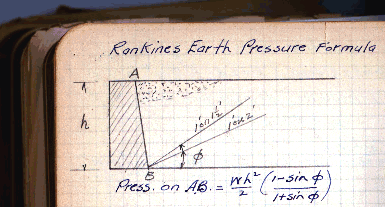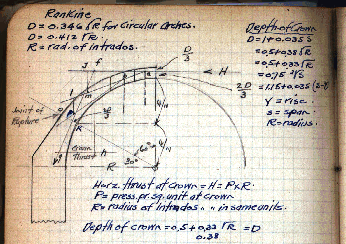 nlike William James, of course, some people used mechanics books precisely as they were intended to be used. That was the case for Loren Plummer, a construction engineer with Lackawanna Steel in Buffalo. In 1906 he bought this 18th edition of Trautwine's Civil Engineering Pocket-Book. Now the binding is flaking, and the gilt-edged pages are falling out. A McDonalds-like note in front says they've sold 80,000 copies since the 1st edition in 1875. The Preface says there's no errata list because there are no errors to correct. This small manual was then common enough engineering currency, and Plummer was energetically practicing civil engineering.
nlike William James, of course, some people used mechanics books precisely as they were intended to be used. That was the case for Loren Plummer, a construction engineer with Lackawanna Steel in Buffalo. In 1906 he bought this 18th edition of Trautwine's Civil Engineering Pocket-Book. Now the binding is flaking, and the gilt-edged pages are falling out. A McDonalds-like note in front says they've sold 80,000 copies since the 1st edition in 1875. The Preface says there's no errata list because there are no errors to correct. This small manual was then common enough engineering currency, and Plummer was energetically practicing civil engineering.
Of Plummer himself we know very little. He was probably only 22 when he got the book. We find another signature in 1914, when he was thirty. That was only 33 years before I began studying engineering. A great deal more time has past since then. I was a lot closer in time to Plummer than I was to our life today. I lived in a vastly different engineering world.
Let us look through this window into the past. "Comparatively few engineers are good mathematicians," the Preface begins. And it goes on to say that's a good thing. Nature, we read, rarely combines high mathematical talent, with that practical sense, and observation of outward things, so essential for an engineer. Well, I would certainly contest that, but I would readily agree that math alone does not make an engineer. Still, math is a big part of the book's 1100 pages. But here mathematics means tools for calculations – logarithms, trig functions, tables of interest, square roots, and chords of circles. No tables of integrals – nothing at all on calculus.
 For the rest, we read about dams and weirs, water pipes, and route surveying. Where would you go today to learn how to lay railroad track? Well, you can learn it here in this book. In the back is a section consisting only of blank lined paper. After all, any really useful handbook must be partly handmade. It should include odd items that only the owner needs. Plummer does not disappoint us. He used this book heavily and the blank pages have been filled with beautifully rendered notes, drawings and calculations – of beams, earthworks, and arches.
For the rest, we read about dams and weirs, water pipes, and route surveying. Where would you go today to learn how to lay railroad track? Well, you can learn it here in this book. In the back is a section consisting only of blank lined paper. After all, any really useful handbook must be partly handmade. It should include odd items that only the owner needs. Plummer does not disappoint us. He used this book heavily and the blank pages have been filled with beautifully rendered notes, drawings and calculations – of beams, earthworks, and arches.
Now and then, in my engineering classes, I would wander away from all the analysis that makes up modern engineering, and talk about locomotives, valves, and refrigerators. Each time I did, the students showed an almost guilty fascination. It's as though the brakes, cables, and bearings that we encounter in this old handbook had become forbidden fruit.
That tension – right in my own classroom – reminded me that we build everything in two places. We build in the mind, and we build in the world. In the last century we stressed building in the world. Now we stress mathematics and analysis – we stress building in the mind. But my students see the onesidedness. They know what their teachers forget.
Pause a moment, they would tell me. Tell us a little about the other world – the world this forgotten engineer, this Loren Plummer, once lived in – this world of stone, iron, and external beauty. One might almost think that they were more alert to Plummer's ghost than I was.

J. C. Trautwine, J. C. Trautwine Jr., J. C. Trautwine 3rd, The Engineer's Pocket-Book. 18th ed., (New York: John Wiley & Sons, 1904). I am very grateful to Engines listener Eric Erdmann for providing me with his old copy of Trautwine.